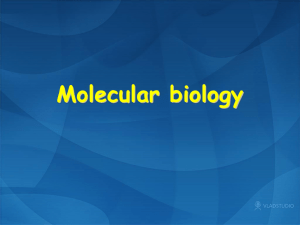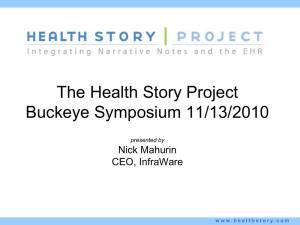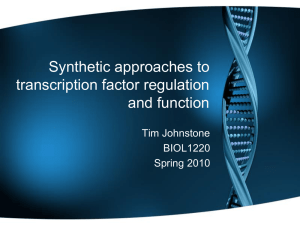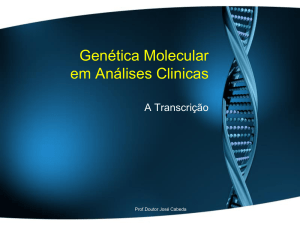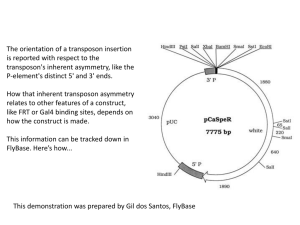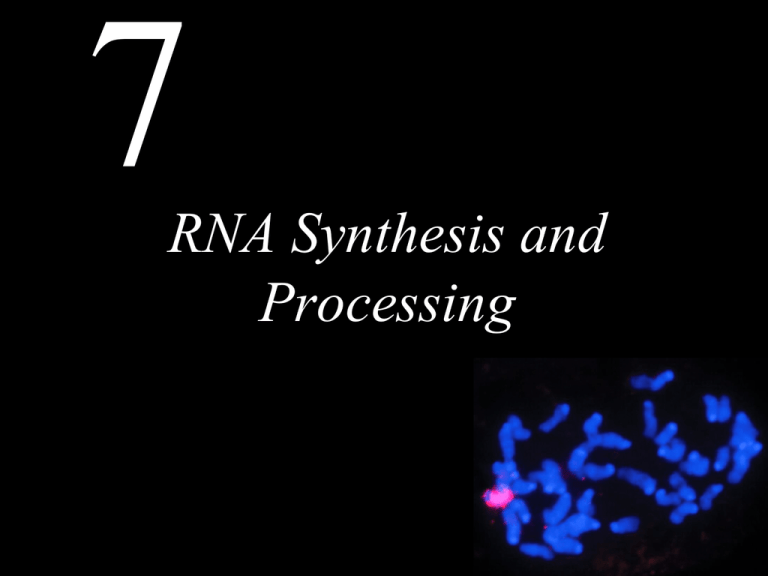
7
RNA Synthesis and
Processing
7 RNA Synthesis and Processing
Chapter Outline
• Transcription in Prokaryotes
• Eukaryotic RNA Polymerases and
General Transcription Factors
• Regulation of Transcription in
Eukaryotes
• RNA Processing and Turnover
Introduction
Regulation of gene expression allows
cells to adapt to environmental
changes and is responsible for the
distinct activities of differentiated cell
types that make up complex
organisms.
Introduction
Transcription is the first step in gene
expression, and the initial level at which
gene expression is regulated.
RNAs in eukaryotic cells are then
modified and processed in various
ways.
Transcription in Prokaryotes
Studies of E. coli have provided the
model for subsequent investigations of
transcription in eukaryotic cells.
mRNA was discovered first in E. coli and
RNA polymerase was purified and
studied.
Transcription in Prokaryotes
RNA polymerase catalyzes
polymerization of ribonucleoside 5′triphosphates (NTPs) as directed by a
DNA template, always in the 5′ to 3′
direction.
Transcription initiates de novo (no
preformed primer required) at specific
sites—this is a major step at which
regulation of transcription occurs.
Transcription in Prokaryotes
Bacterial RNA polymerase has five types
of subunits.
The σ subunit is weakly bound and can
be separated from the others. It
identifies the correct sites for
transcription initiation.
Most bacteria have several different σ’s
that direct RNA polymerase to different
start sites under different conditions.
Figure 7.1 E. coli RNA polymerase
Transcription in Prokaryotes
Promoter: gene sequence to which
RNA polymerase binds to initiate
transcription.
Promoters are 6 nucleotides long and
are located at 10 and 35 base pairs
upstream of the transcription start site.
Consensus sequences are the bases
most frequently found in different
promoters.
Figure 7.2 Sequences of E. coli promoters
Transcription in Prokaryotes
Experiments show the functional
importance of –10 and –35 regions:
• Genes with promoters that differ from
the consensus sequences are
transcribed less efficiently.
• Mutations in these sequences affect
promoter function.
• The σ subunit binds to both regions.
Transcription in Prokaryotes
Initially, the DNA is not unwound
(closed-promoter complex).
The polymerase then unwinds 12–14
bases of DNA to form an openpromoter complex, allowing
transcription.
After addition of about ten nucleotides, σ
is released from the polymerase.
Figure 7.3 Transcription by E. coli RNA polymerase
Transcription in Prokaryotes
During elongation, polymerase maintains
an unwound region of about 15 base
pairs.
High-resolution structural analysis shows
the β and β′ subunits form a crab-clawlike structure that grips the DNA
template.
A channel between these subunits
contains the polymerase active site.
Figure 7.4 Structure of bacterial RNA polymerase
Transcription in Prokaryotes
RNA synthesis continues until the
polymerase encounters a stop signal.
The most common stop signal is a
symmetrical inverted repeat of a GCrich sequence followed by seven A
residues.
Transcription in Prokaryotes
Transcription of the GC-rich inverted
repeat results in a segment of RNA that
can form a stable stem-loop structure.
This disrupts its association with the
DNA template and terminates
transcription.
Figure 7.5 Transcription termination
Transcription in Prokaryotes
Alternatively, transcription of some
genes is terminated by a specific
termination protein (Rho), which binds
extended segments of single-stranded
RNA.
Transcription in Prokaryotes
Most transcriptional regulation in
bacteria operates at initiation.
Studies of gene regulation in the 1950s
used enzymes involved in lactose
metabolism.
The enzymes are only expressed when
lactose is present.
Transcription in Prokaryotes
Three enzymes are involved:
• β-galactosidase cleaves lactose into
glucose and galactose.
• Lactose permease transports lactose
into the cell.
• Transacetylase inactivates toxic
thiogalactosides that are transported
into the cell along with lactose.
Figure 7.6 Metabolism of lactose
Transcription in Prokaryotes
Genes encoding these enzymes are
expressed as a single unit, called an
operon.
Two loci control transcription:
o (operator), adjacent to
transcription initiation site
i (not in the operon), encodes a
protein that binds to the operator.
Figure 7.7 Negative control of the lac operon
Transcription in Prokaryotes
Mutants that don’t produce i gene product
express the operon even when lactose is
not available.
This implies that the normal i gene product
is a repressor, which blocks transcription
when bound to o.
When lactose is present in normal cells, it
binds to the repressor, preventing it from
binding to the operator, and the genes
are expressed.
Transcription in Prokaryotes
The lactose operon illustrates the central
principle of gene regulation:
Control of transcription is mediated by the
interaction of regulatory proteins with
specific DNA sequences.
Transcription in Prokaryotes
Cis-acting control elements affect
expression of linked genes on the same
DNA molecule (e.g., the operator).
Other proteins can affect expression of
genes on other chromosomes (e.g., the
repressor).
The lac operon is an example of negative
control—binding of the repressor blocks
transcription.
Transcription in Prokaryotes
Negative control: the regulatory protein
(the repressor) blocks transcription.
Positive control: regulatory proteins
activate rather than inhibit transcription.
Transcription in Prokaryotes
Example of positive control in E. coli:
Presence of glucose (preferred energy
source) represses expression of the lac
operon, even if lactose is also present.
This is mediated by a positive control
system: If glucose decreases, levels of
cAMP increase.
Transcription in Prokaryotes
cAMP binds to the regulatory protein
catabolite activator protein (CAP).
This stimulates CAP to binds to its target
DNA sequence upstream of the lac
operon.
CAP facilitates binding of RNA
polymerase to the promoter.
Figure 7.8 Positive control of the lac operon by glucose
Eukaryotic RNA Polymerases and General Transcription Factors
Transcription in eukaryotes:
• Eukaryotic cells have three RNA
polymerases that transcribe different
classes of genes.
• The RNA polymerases must interact
with additional proteins to initiate and
regulate transcription.
Eukaryotic RNA Polymerases and General Transcription Factors
• Transcription takes place on chromatin;
regulation of chromatin structure is
important in regulating gene
expression.
Eukaryotic RNA Polymerases and General Transcription Factors
Eukaryotic RNA polymerases are
complex enzymes, consisting of 12 to
17 different subunits.
They all have 9 conserved subunits, 5 of
which are related to subunits of
bacterial RNA polymerase.
Yeast RNA polymerase II is strikingly
similar to that of bacteria.
Table 7.1 Classes of genes transcribed by eukaryotic RNA polymerases
Figure 7.9 Structure of yeast RNA polymerase II
Eukaryotic RNA Polymerases and General Transcription Factors
RNA polymerase II synthesizes mRNA
and has been the focus of most
transcription studies.
Unlike prokaryotic RNA polymerase, it
requires initiation factors that (in
contrast to bacterial σ factors) are not
associated with the polymerase.
Eukaryotic RNA Polymerases and General Transcription Factors
General transcription factors are
proteins involved in transcription from
polymerase II promoters.
About 10% of the genes in the human
genome encode transcription factors,
emphasizing the importance of these
proteins.
Eukaryotic RNA Polymerases and General Transcription Factors
Promoters contain several different
sequence elements surrounding their
transcription sites.
The TATA box resembles the –10
sequence of bacterial promoters.
Others include initiator (Inr) elements,
TFIIB recognition elements (BRE), and
downstream elements DCE, MTE, and
DPE).
Figure 7.10 Formation of a polymerase II preinitiation complex in vitro (Part 1)
Eukaryotic RNA Polymerases and General Transcription Factors
Five general transcription factors are
required for initiation of transcription in
vitro.
General transcription factor TFIID is
composed of multiple subunits,
including the TATA-binding protein
(TBP) and other subunits (TAFs) that
bind to the Inr, DCE, MTE, and DPE
sequences.
Eukaryotic RNA Polymerases and General Transcription Factors
Several other transcription factors
(TFIIB, TFIIF, TFIIE, and TFIIH) bind in
association with the RNA polymerase II
to form the preinitiation complex.
Figure 7.10 Formation of a polymerase II preinitiation complex in vitro (Part 2)
Eukaryotic RNA Polymerases and General Transcription Factors
Within a cell, additional factors are
required to initiate transcription.
These include Mediator, a protein
complex of more than 20 subunits; it
interacts with both general transcription
factors and RNA polymerase.
Figure 7.11 RNA polymerase II/Mediator complexes and transcription initiation
Eukaryotic RNA Polymerases and General Transcription Factors
RNA polymerase I transcribes rRNA
genes, which are present in tandem
repeats.
Transcription yields a large 45S prerRNA, which is processed to yield the
28S, 18S, and 5.8S rRNAs.
Figure 7.12 The ribosomal RNA gene
Eukaryotic RNA Polymerases and General Transcription Factors
Promoters of rRNA genes are
recognized by two transcription factors
which recruit RNA polymerase I to form
and initiation complex.
UBF (upstream binding factor)
SL1 (selectivity factor 1)
Figure 7.13 Initiation of rDNA transcription
Eukaryotic RNA Polymerases and General Transcription Factors
Genes for tRNAs, 5S rRNA, and some of
the small RNAs are transcribed by
polymerase III.
They are expressed from three types of
promoters.
Figure 7.14 Transcription of RNA polymerase III genes
Regulation of Transcription in Eukaryotes
Eukaryotic DNA is packaged into
chromatin, which limits its availability as
a template for transcription.
Non-coding RNAs and proteins regulate
transciption via modifications of
chromatin structure.
Regulation of Transcription in Eukaryotes
Many cis-acting sequences regulate
expression of eukaryotic genes.
These regulatory sequences have been
identified by gene transfer assays.
Regulation of Transcription in Eukaryotes
Gene transfer assays:
Regulatory sequences are ligated to a
reporter gene that encodes an easily
detectable enzyme, such as firefly
luciferase.
The regulatory sequence directs
expression of the reporter gene in
cultured cells.
Figure 7.15 Identification of eukaryotic regulatory sequences
Regulation of Transcription in Eukaryotes
Two cis-acting regulatory sequences
were identified by studies of the
promoter of the herpes simplex virus
gene that encodes thymidine kinase.
They include TATA and GC boxes.
cis-acting regulatory sequences are
usually located upstream of the
transcription start site.
Figure 7.16 A eukaryotic promoter
Regulation of Transcription in Eukaryotes
Enhancers: regulatory sequences
located farther away from the start site.
First identified in studies of the promoter
of virus SV40.
Activity of enhancers does not depend
on their distance from, or orientation
with respect to the transcription
initiation site.
Figure 7.17 The SV40 enhancer
Figure 7.18 Action of enhancers
Regulation of Transcription in Eukaryotes
Enhancers, like promoters, function by
binding transcription factors that then
regulate RNA polymerase.
DNA looping allows a transcription factor
bound to a distant enhancer to interact
with proteins associated with the RNA
polymerase/Mediator complex at the
promoter.
Figure 7.19 DNA looping
Regulation of Transcription in Eukaryotes
Example: an enhancer controls
transcription of immunoglobulin genes in
B lymphocytes.
Gene transfer experiments show that the
enhancer is active in lymphocytes, but
not in other cell types.
This regulatory sequence is partly
responsible for tissue-specific expression
of the immunoglobulin genes.
Regulation of Transcription in Eukaryotes
Enhancers usually have multiple
sequence elements that bind different
regulatory proteins that work together
to regulate gene expression.
The immunoglobulin heavy-chain
enhancer has at least nine distinct
sequence elements that serve as
protein-binding sites.
Figure 7.20 The immunoglobulin enhancer
Regulation of Transcription in Eukaryotes
The immunoglobulin enhancer contains
positive regulatory elements that
activate transcription in B lymphocytes
and negative regulatory elements that
inhibit transcription in other cell types.
The overall activity reflects the combined
action of the proteins associated with
each of the sequence elements.
Regulation of Transcription in Eukaryotes
Activity of any given enhancer is specific
for the promoter of its appropriate
target gene.
Specificity is maintained partly by
insulators or barrier elements, which
divide chromosomes into independent
domains and prevent enhancers from
acting on promoters located in an
adjacent domain.
Figure 7.21 Insulators
Regulation of Transcription in Eukaryotes
Transcription factor binding sites have
been identified by several types of
experiments:
Electrophoretic-mobility shift assay:
Radiolabeled DNA fragments are
incubated with a protein and then
subjected to electrophoresis in a nondenaturing gel.
Migration of a DNA fragment is slowed by
a bound protein.
Figure 7.22 Electrophoretic-mobility shift assay
Regulation of Transcription in Eukaryotes
Binding sites are usually short DNA
sequences (6–10 base pairs) and they
are degenerate:
The transcription factor will bind to the
consensus sequence, but also to
sequences that differ from the
consensus at one or more positions.
Regulation of Transcription in Eukaryotes
Transcription factor binding sites are
shown as pictograms, representing the
frequency of each base at all positions
of known binding sites for a given
factor.
Figure 7.23 Representative transcription factor binding sites
Regulation of Transcription in Eukaryotes
Chromatin immunoprecipitation:
Cells are treated with formaldehyde to
cross-link transcription factors to the DNA
sequences to which they were bound.
Chromatin is extracted and fragmented.
Fragments of DNA linked to a
transcription factor can then be isolated
by immunoprecipitation.
Figure 7.24 Chromatin immunoprecipitation (Part 1)
Figure 7.24 Chromatin immunoprecipitation (Part 2)
Regulation of Transcription in Eukaryotes
One of the first transcription factors to be
isolated was Sp1, in studies of SV40
virus, by Tjian and colleagues.
Sp1 was shown to bind to GC boxes in
the SV40 promoter. This established
the action of Sp1 and also suggested a
method for purification of transcription
factors.
Key Experiment, Ch. 7, p. 259 (1)
Key Experiment, Ch. 7, p. 259 (2)
Regulation of Transcription in Eukaryotes
DNA-affinity chromatography:
Double-stranded oligonucleotides with
repeated GC box sequences are bound
to agarose beads in a column.
Cell extracts are passed through the
column. Sp1 binds to the GC box with
high affinity and is retained on the
column.
Figure 7.25 Purification of Sp1 by DNA-affinity chromatography
Regulation of Transcription in Eukaryotes
Transcriptional activators, like Sp1,
bind to regulatory DNA sequences and
stimulate transcription.
These factors have two independent
domains: one region binds DNA, the
other stimulates transcription by
interacting with other proteins such as
Mediator.
Figure 7.26 Structure of transcriptional activators
Regulation of Transcription in Eukaryotes
Many different transcription factors have
now been identified in eukaryotic cells.
About 2000 are encoded in the human
genome.
They contain many distinct types of
DNA-binding domains.
Regulation of Transcription in Eukaryotes
DNA binding domains:
1. Zinc finger domain: binds zinc ions
and folds into loops (“fingers”) that bind
DNA.
Steroid hormone receptors have zinc
fingers; they regulate gene transcription
in response to hormones such as
estrogen and testosterone.
Figure 7.27 Examples of DNA-binding domains (Part 1)
Figure 7.27 Examples of DNA-binding domains (Part 2)
Regulation of Transcription in Eukaryotes
2. Helix-turn-helix domain: one helix
makes most of the contacts with DNA,
the other helices lie across the complex
to stabilize the interaction.
They include homeodomain proteins,
important in the regulation of gene
expression during embryonic
development.
Regulation of Transcription in Eukaryotes
Homeodomain proteins were first
discovered as developmental mutants
in Drosophila.
They result in development of flies in
which one body part is transformed into
another.
In Antennapedia, legs rather than
antennae grow from the head.
Figure 7.28 The Antennapedia mutation (Part 1)
Figure 7.28 The Antennapedia mutation (Part 2)
Regulation of Transcription in Eukaryotes
3. Leucine zipper and helix-loop-helix
proteins contain DNA-binding domains
formed by dimerization of two
polypeptide chains.
Different members of each family can
dimerize with one another—
combinations can form an expanded
array of factors.
Figure 7.27 Examples of DNA-binding domains (Part 3)
Figure 7.27 Examples of DNA-binding domains (Part 4)
Regulation of Transcription in Eukaryotes
The activation domains of transcription
factors are not as well characterized as
their DNA-binding domains.
Activation domains stimulate
transcription by two mechanisms:
• Interact with Mediator proteins and
general transcription factors
• Interact with coactivators to modify
chromatin structure.
Figure 7.30 Action of eukaryotic repressors
Regulation of Transcription in Eukaryotes
Gene expression is also regulated by
repressors which inhibit transcription.
In some cases, they simply interfere with
binding of other transcription factors.
Other repressors compete with
activators for binding to specific
regulatory sequences.
Figure 7.30 Action of eukaryotic repressors (Part 1)
Regulation of Transcription in Eukaryotes
Active repressors have specific domains
that inhibit transcription via proteinprotein interactions.
These include interactions with specific
activator proteins, with Mediator
proteins or general transcription
factors, and with corepressors that act
by modifying chromatin structure.
Figure 7.30 Action of eukaryotic repressors (Part 2)
Regulation of Transcription in Eukaryotes
Transcription can also be regulated at
elongation.
Recent studies show that many genes
have molecules of RNA polymerase II
that have started transcription but are
stalled immediately downstream of
promoters.
Regulation of Transcription in Eukaryotes
Following initiation, the polymerase
pauses within about 50 nucleotides due
to negative regulatory factors, including
NELF (negative elongation factor) and
DSIF.
Continuation depends on another factor:
P-TEFb (positive transcriptionelongation factor-b).
Figure 7.31 Regulation of transcriptional elongation (Part 1)
Figure 7.31 Regulation of transcriptional elongation (Part 2)
Regulation of Transcription in Eukaryotes
The packaging of eukaryotic DNA in
chromatin has important consequences
for transcription, so chromatin structure
is a critical aspect of gene expression.
Actively transcribed genes are in
relatively decondensed chromatin,
which can be seen in polytene
chromosomes of Drosophila.
Figure 7.32 Decondensed chromosome regions in Drosophila
Regulation of Transcription in Eukaryotes
But actively transcribed genes remain
bound to histones and packaged in
nucleosomes.
The tight winding of DNA around
nucleosomes is a major obstacle to
transcription.
Chromatin can be altered by histone
modifications and nucleosome
rearrangements.
Regulation of Transcription in Eukaryotes
Histone acetylation:
The amino-terminal tail domains of core
histones are rich in lysine and can be
modified by acetylation.
Transcriptional activators and repressors
are associated with histone
acetyltransferases (HAT) and
deacetylases (HDAC), respectively.
Figure 7.33 Histone acetylation (Part 1)
Figure 7.33 Histone acetylation (Part 2)
Regulation of Transcription in Eukaryotes
Histones can also be modified by
methylation of lysine and arginine
residues, phosphorylation of serine
residues, and addition of small peptides
(ubiquitin and SUMO) to lysine
residues.
These modifications occur at specific
amino acid residues in the histone tails.
Figure 7.34 Patterns of histone modification (Part 1)
Regulation of Transcription in Eukaryotes
Different patterns of histone modification
are found at promoters compared with
enhancers.
Example: distinct patterns of lysine-4
methylation are characteristic of
enhancers and promoters.
Figure 7.34 Patterns of histone modification (Part 2)
Regulation of Transcription in Eukaryotes
Histone modification provides a
mechanism for epigenetic inheritance
—transmission of information that is not
in the DNA sequence.
Modified histones are transferred to both
progeny chromosomes where they direct
similar modification of new histones—
maintaining characteristic patterns of
histone modification.
Figure 7.35 Epigenetic inheritance of histone modifications
Regulation of Transcription in Eukaryotes
Chromatin remodeling factors are
protein complexes that alter contacts
between DNA and histones.
They can reposition nucleosomes,
change the conformation of
nucleosomes, or eject nucleosomes
from the DNA.
Figure 7.36 Chromatin remodeling factors
Regulation of Transcription in Eukaryotes
To facilitate elongation, elongation
factors become associated with the
phosphorylated C-terminal domain of
RNA polymerase II.
They include histone modifying enzymes
and chromatin remodeling factors that
transiently displace nucleosomes
during transcription.
Regulation of Transcription in Eukaryotes
Transcription can also be regulated by
noncoding RNA molecules:
Small-interfering RNAs (siRNAs)
MicroRNAs (miRNAs).
Regulation of Transcription in Eukaryotes
siRNAs repress transcription of target
genes by inducing histone
modifications that lead to chromatin
condensation and formation of
heterochromatin.
In the yeast S. pombe, siRNAs direct
formation of heterochromatin at
centromeres.
Regulation of Transcription in Eukaryotes
The siRNAs associate with RNAinduced transcriptional silencing
(RITS) complex.
RITS includes proteins that induce
chromatin condensation and
methylation of histone H3 lysine-9.
Figure 7.37 Regulation of transcription by siRNAs
Regulation of Transcription in Eukaryotes
Long noncoding RNAs also regulate
gene expression:
X chromosome inactivation occurs
during development when most genes
on one X chromosome in female cells
are inactivated.
This compensates for the fact that
females have twice as many copies of
most X chromosome genes as males.
Regulation of Transcription in Eukaryotes
Noncoding RNA transcribed from a
regulatory gene, Xist, on the inactive X
chromosome, binds to and coats this
chromosome.
This leads to chromatin condensation
and conversion to heterochromatin.
Figure 7.38 X chromosome inactivation
Regulation of Transcription in Eukaryotes
Recent sequencing research suggests
there are many long noncoding RNAs
(lncRNAs) transcribed from the human
genome that are functional regulators of
gene expression.
lncRNAs associate with chromatin
regulatory proteins, and may recruit
chromatin modifying proteins to target
genes.
Regulation of Transcription in Eukaryotes
DNA methylation also controls
transcription in eukaryotes:
Methyl groups are added at the 5-carbon
position of cytosines (C) that precede
guanines (G) (CpG dinucleotides).
This methylation is correlated with
transcriptional repression.
Figure 7.39 DNA methylation
Regulation of Transcription in Eukaryotes
Methylation is common in transposable
elements; it plays a key role in
suppressing their movement.
DNA methylation also plays a role in X
chromosome inactivation.
Regulation of Transcription in Eukaryotes
DNA methylation is a mechanism for
epigenetic inheritance.
Following DNA replication, an enzyme
methylates CpG sequences of a
daughter strand that is hydrogenbonded to a methylated parental
strand.
Figure 7.40 Maintenance of methylation patterns
Regulation of Transcription in Eukaryotes
DNA methylation plays a role in
genomic imprinting: the expression of
some genes depends on whether they
come from the mother or the father.
Example: gene H19 is transcribed only
from the maternal copy. It is specifically
methylated during the development of
male, but not female, germ cells.
Figure 7.41 Genomic imprinting
RNA Processing and Turnover
Bacterial mRNAs are used immediately
for protein synthesis while still being
transcribed.
Other RNAs must be processed in
various ways in both prokaryotic and
eukaryotic cells.
Regulation of processing provides
another level of control of gene
expression.
RNA Processing and Turnover
Ribosomal RNAs of both prokaryotes
and eukaryotes are derived from a
single long pre-rRNA molecule.
In prokaryotes, this is cleaved to form
three rRNAs (16S, 23S, and 5S).
Eukaryotes have four rRNAs; 5S rRNA
is transcribed from a separate gene.
Figure 7.42 Processing of ribosomal RNAs
RNA Processing and Turnover
tRNAs also start as long precursors
(pre-tRNAs) in prokaryotes and
eukaryotes.
Processing of the 5′ end of pre-tRNAs
involves cleavage by the enzyme
RNase P.
RNase P is a ribozyme—an enzyme in
which RNA rather than protein is
responsible for catalytic activity.
Figure 7.43 Processing of transfer RNAs (Part 1)
RNA Processing and Turnover
Processing of the 3′ end of tRNAs
involves addition of a CCA terminus,
the site of amino acid attachment.
Bases are also modified at specific
positions. About 10% of the bases are
modified.
Figure 7.43 Processing of transfer RNAs (Part 2)
RNA Processing and Turnover
In eukaryotes, pre-mRNAs are
extensively modified before export from
the nucleus.
Transcription and processing are
coupled.
The C-terminal domain (CTD) of RNA
polymerase II plays a key role in
coordinating these processes.
RNA Processing and Turnover
The 5′ end of the transcript is modified
by addition of a 7-methylguanosine
cap.
Enzymes responsible for capping are
recruited to the phosphorylated CTD
following initiation, and the cap is
added after transcription of the first 20
to 30 nucleotides.
Figure 7.44 Processing of eukaryotic messenger RNAs
RNA Processing and Turnover
At the 3′ end, a poly-A tail is added by
polyadenylation.
Signals for polyadenylation include a
highly conserved hexanucleotide
(AAUAAA in mammalian cells), and a
G-U rich downstream sequence
element.
Figure 7.45 Formation of the 3' ends of eukaryotic mRNAs
RNA Processing and Turnover
Recognition of the polyadenylation
signal leads to termination of
transcription, cleavage, and
polyadenylation of the mRNA
The RNA that has been synthesized
downstream of the site of poly-A
addition is degraded.
RNA Processing and Turnover
Introns (noncoding sequences) are
removed from pre-mRNA by splicing.
In mammals, most genes contain
multiple introns.
Splicing has to be highly specific to yield
functional mRNAs.
RNA Processing and Turnover
In vitro systems were used to study
splicing:
A gene containing an intron is cloned
adjacent to a promoter for a
bacteriophage RNA polymerase.
Transcription of these plasmids produced
pre-mRNAs that, when added to nuclear
extracts of mammalian cells, were found
to be correctly spliced.
Figure 7.46 In vitro splicing
RNA Processing and Turnover
Splicing proceeds in two steps:
1. Cleavage at the 5′ splice site (SS) and
joining of the 5′ end of the intron to an
A within the intron (branch point). The
intron forms a loop.
2. Cleavage at the 3′ SS and
simultaneous ligation of the exons
excises the intron loop.
Figure 7.47 Splicing of pre-mRNA
RNA Processing and Turnover
Three sequence elements of premRNAs are important:
At the 5′ splice site, at the 3′ splice site,
and within the intron at the branch
point.
Pre-mRNAs contain similar consensus
sequences at each of these positions.
RNA Processing and Turnover
Splicing takes place in large complexes,
called spliceosomes, which have five
types of small nuclear RNAs
(snRNAs)—U1, U2, U4, U5, and U6.
The snRNAs are complexed with 6–10
protein molecules to form small
nuclear ribonucleoprotein particles
(snRNPs).
Key Experiment, Ch. 7, p. 284 (1)
Key Experiment, Ch. 7, p. 284 (2)
RNA Processing and Turnover
First step in spliceosome assembly:
binding of U1 snRNP to the 5′ SS.
Recognition of 5′ SS involves base
pairing between the 5′ SS consensus
sequence and a complementary
sequence at the 5′ end of U1 snRNA.
Figure 7.48 Assembly of the spliceosome (Part 1)
Figure 7.49 Binding of U1 snRNA to the 5' splice site
RNA Processing and Turnover
U2 snRNP then binds to the branch
point.
The other snRNPs join the complex and
act together to form the intron loop, and
maintain the association of the 5′ and 3′
exons so they can be ligated followed
by excision of the intron.
Figure 7.48 Assembly of the spliceosome (Part 2)
RNA Processing and Turnover
snRNAs recognize consensus
sequences at the branch and splice
sites, and also catalyze the splicing
reaction.
Some RNAs can self-splice: they can
catalyze removal of their own introns in
the absence of other protein or RNA
factors.
RNA Processing and Turnover
Two groups of self-splicing introns:
Group I—cleavage at 5′ SS mediated by
a guanosine cofactor.
Group II—cleavage of 5′ SS results from
attack by an adenosine nucleotide in
the intron.
Figure 7.50 Self-splicing introns
RNA Processing and Turnover
Other splicing factors bind to RNA and
recruit U1 and U2 snRNPs to the
appropriate sites on pre-mRNA.
SR splicing factors bind to specific
sequences in exons and recruit U1
snRNP to the 5′ SS.
U2AF binds to pyrimidine-rich sequences
at the 3′ SS and recruits U2 snRNP to the
branch point.
Figure 7.51 Role of splicing factors in spliceosome assembly
RNA Processing and Turnover
Alternative splicing occurs frequently
in genes of complex eukaryotes.
Most pre-mRNAs have multiple introns,
thus different mRNAs can be produced
from the same gene.
This provides a means of controlling
gene expression, and increases the
diversity of proteins that can be
encoded.
RNA Processing and Turnover
Sex determination in Drosophila is an
example of tissue-specific alternative
splicing.
Alternative splicing of transformer mRNA
is regulated by the SXL protein, which
is only expressed in females.
SXL acts as a repressor that blocks
splicing factor U2AF.
Figure 7.52 Alternative splicing in Drosophila sex determination
RNA Processing and Turnover
The Dscam gene of Drosophila contains
four sets of exons; one from each set
goes into the spliced mRNA in any
combination, potentially yielding 38,016
different mRNAs.
Different forms of Dscam provide
neurons with an identity code essential
in establishing connections between
neurons for brain development.
Figure 7.53 Alternative splicing of Dscam
RNA Processing and Turnover
RNA editing: processing (other than
splicing) that can alter the proteincoding sequences of mRNAs.
It involves single base modification
reactions such as deamination of
cytosine to uridine and adenosine to
inosine.
RNA Processing and Turnover
Editing of the mRNA for apolipoprotein B,
which transports lipids in the blood,
results in two different proteins:
Apo-B100, synthesized in the liver by
translation of unedited mRNA.
Apo-B48, synthesized in the intestine
from edited mRNA in which a C has
been changed to a U by deamination.
Figure 7.54 Editing of apolipoprotein B mRNA
RNA Processing and Turnover
Over 90% of pre-mRNA sequences are
introns, which are degraded in the
nucleus after splicing.
Processed mRNAs are protected by
capping and polyadenylation, but the
unprotected ends of introns are
recognized and degraded by enzymes.
RNA Processing and Turnover
Aberrant mRNAs can also be degraded.
Nonsense-mediated mRNA decay
eliminates mRNAs that lack complete
open-reading frames.
When ribosomes encounter premature
termination codons, translation stops
and the defective mRNA is degraded.
RNA Processing and Turnover
Ultimately, RNAs are degraded in the
cytoplasm.
Levels of any RNA are determined by a
balance between synthesis and
degradation.
Rate of degradation can thus control
gene expression.
RNA Processing and Turnover
rRNAs and tRNAs are very stable, in
both prokaryotes and eukaryotes.
This accounts for the high levels of these
RNAs (greater than 90% of all RNA) in
cells.
RNA Processing and Turnover
Bacterial mRNAs are rapidly degraded,
most have half-lives of 2–3 minutes.
Rapid turnover allows the cell to respond
quickly to changes in its environment,
such as nutrient availability.
RNA Processing and Turnover
In eukaryotic cells, mRNA half-lives vary;
less than 30 minutes to 20 hours in
mammalian cells.
Short-lived mRNAs code for regulatory
proteins, levels of which can vary rapidly
in response to environmental stimuli.
mRNAs encoding structural proteins or
central metabolic enzymes have long
half-lives.
RNA Processing and Turnover
Degradation of eukaryote mRNAs is
initiated by shortening of the poly-A
tails.
Rapidly degraded mRNAs often contain
specific AU-rich sequences near the 3′
ends, which are binding sites for
proteins that can either stabilize them
or target them for degradation.
Figure 7.55 mRNA degradation
RNA Processing and Turnover
These RNA-binding proteins are
regulated by extracellular signals, such
as growth factors and hormones.
Degradation of some mRNAs is
regulated by both siRNAs and miRNA.



